It has been a busy few years in New Jersey in terms of improving the safety of the State’s pedestrians through the implementation of significant pedestrian infrastructure projects. The following article highlights a few of these projects.
Main Street – Little Falls, NJ
One of the more interesting projects, in terms of its implementation, has occurred in Little Falls Township, located in Passaic County. In July of 2008, the Tri-State Transportation Campaign (TSTC), with the involvement of the Little Falls Alliance for a Better Community (ABC); organized a walking tour of downtown Little Falls to identify pedestrian and cyclist safety concerns.[1] The walking tour was funded through the support of an anonymous private donor and the Community Foundation of New Jersey. Following the tour, TSTC issued a report featuring a series of recommendations to improve the pedestrian environment downtown. The report focused on downtown Little Falls’ transit connectivity and stressed the importance of safe pedestrian linkages to these transit assets in order to improve the prospects of downtown revitalization.
Included in the report were specific recommendations to improve the visibility of crosswalks located on Main Street at the intersections of Patterson Avenue and Stevens Avenue.[2] Previously, the intersection at Patterson was marked with standard, parallel striped crosswalks. The intersection at Stevens used a similar approach but differed in that the area between the parallel lines was filled in with green paint. The report called for all downtown crosswalks to use the same treatments upon improvement.
The same anonymous donor funded the implementation of TSTC’s recommendations on Main Street at the intersections of Patterson and Stevens Avenues. In 2011, high visibility crosswalks were installed which utilize 8 inch parallel striped crosswalks that added a stamped asphalt “brick pattern” between the stripes to make them more visually attractive.
[column size=half position=first ]
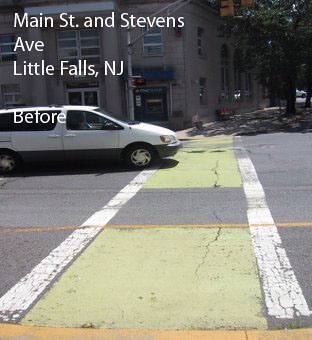
[/column]
[column size=half position=last]
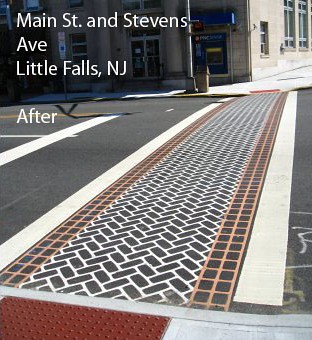
[/column]
Hudson Place – Hoboken, NJ
Recently, the City of Hoboken began a massive effort to improve pedestrian conditions on Hudson Place – a major thoroughfare linking the downtown to the multi-modal Hoboken Terminal. The project consisted of two phases. Phase I of the project began on October 19, 2010 and Phase II began on June 20, 2011. The projects totaled $160,000 and were funded by the New Jersey Department of Transportation’s Safe Streets to Transit grant program. These projects, combined with a series of other innovative methods to encourage walking in Hoboken led to the Pedestrian and Bicycle Information Center naming the city a Gold-Level Walk Friendly Community.
Phase I of the project entailed replacing the sidewalk along the Hudson Place’s southern end between Hudson and River Streets and widening it. Previously, congested sidewalks forced pedestrians to enter the roadway during their journeys to and from the terminal. The hope was that a significantly wider sidewalk would deter this type of behavior and thus improve the safety of pedestrians in the area. Curb extensions were also put in place at the intersections to narrow the distance for pedestrians to cross Hudson Street and Hudson Place. The result was narrower vehicle lanes which further improved pedestrian safety by slowing vehicle traffic near the terminal.
Phase II of the project continued widening the sidewalk on the southern end of Hudson place further eastward. This area is significant because it is the entrance to Hoboken’s Path Station, which links Hoboken to Manhattan and Jersey City. This project also included the installation of a curb bump-out on the northeast corner of the intersection of Hudson Place and River Street to compliment the ones installed during Phase I. The project also included the installation of new bike racks near the terminal and also replaced the sidewalks near the taxi stand.
Lincoln Highway (Rt. 1 & 9) Bridge – Jersey City, NJ
The Lincoln Highway Bridge that carries NJ Route 1 & 9 Truck over the Hackensack River from Kearny into Jersey City was built in 1954. It was built at a time when vehicular and maritime mobility in the region was a priority. A major arterial for heavy truck traffic, the 1,600 foot span carries over 60,000 vehicles a day according to the latest traffic volumes collected by NJDOT. While pedestrian accommodation on the bridge structure does exist, access to these areas was practically impossible and what “path” did exist was located on land that was uneven and often covered with debris. To fix this disconnect, NJDOT constructed new sidewalks on the westbound approach of the bridge, and connected to existing pedestrian facilities on the Kearny side of the river. Construction was completed in late 2011. The completion of this segment of sidewalk establishes the final link needed to complete New Jersey’s portion of the East Coast Greenway (ECG). By constructing this approach, the ECG is 100% complete, allowing travelers the ability to cross the entire state of New Jersey by foot or bike.
[column size=half position=first ]
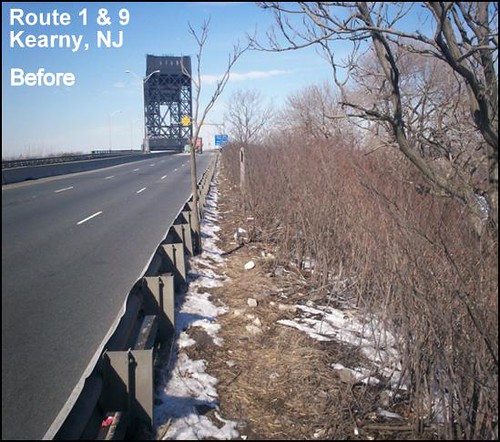
[/column]
[column size=half position=last]
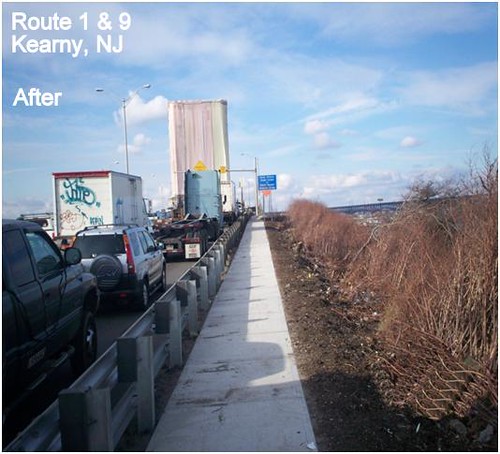
[/column]
Route 15 – Dover, NJ
Pedestrian safety has been a long standing issue in Dover, NJ. In 2006, the town prepared a master plan which identified 59 crashes (33 fatal) involving pedestrians between 2002 and 2005. An area of key concern highlighted in the circulation element of the master plan was a section of Route 15, north of Baker Street, to the town’s border.[3] This section of roadway was identified as a highly traveled pedestrian corridor that did not have sidewalks on either side for some segments. This was of great concern, due to the proximity of local businesses and the location of the Dover High School and an elementary school nearby. The installation of new sidewalks along this stretch is just part of a series of ongoing NJDOT projects throughout town to improve the mobility of Dover’s residents.
[column size=half position=first ]
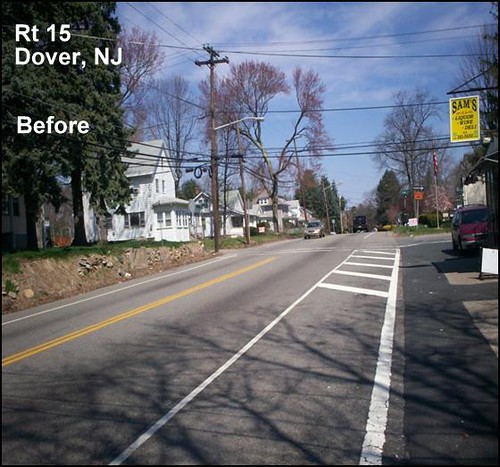
[/column]
[column size=half position=last]

[/column]
Route 30 – Atlantic City & Hammonton, NJ
Route 30 (Black Horse Pike) in Atlantic County has long been known as a hazardous roadway for pedestrians in New Jersey. In their latest report documenting the most dangerous roads in the tri-state area, TSTC ranked this stretch of highway the fourth most dangerous road in New Jersey.[4] This is an improvement over last year’s ranking of number two. Perhaps this is due to NJDOT’s installation of sidewalks in multiple locations throughout the county.
Elsewhere in Atlantic County, Hamilton and Pleasantville saw the installation of over 5,000 linear feet of sidewalk along stretches of Route 40/322 that totaled $386,000 in costs. Several other pedestrian improvement projects occurred elsewhere throughout the county, along some precarious stretches of Route 30.
One project in particular was completed at the intersection of North Carolina Avenue and Route 30 in Atlantic City. Pedestrian accommodations included the installation of new sidewalks and high visibility crosswalks, establishing the preferred path for crossing at the intersection. This path directs pedestrians to cross a seven lane section of route 30 on the eastern leg, and includes a pedestrian refuge in the median.
[column size=half position=first ]

[/column]
[column size=half position=last]
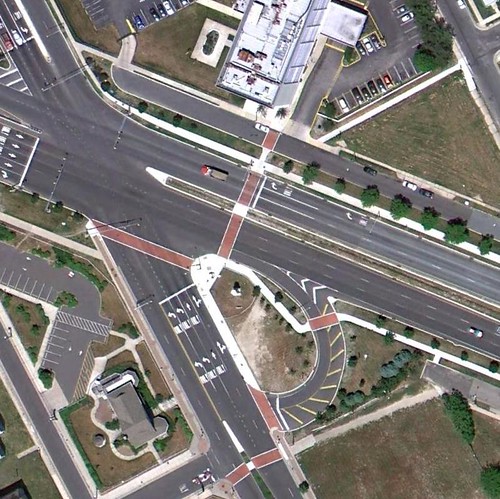
[/column]
In a second project on Route 30 new sidewalks were installed in Hammonton NJ, where the highway intersects with Routes 54 and 206. From the pictures, it can be seen that prior to installation, dirt paths, (desire lines) were present. This indicated a high level of pedestrian travel along this segment and a need for the sidewalks to be installed.
[column size=half position=first ]
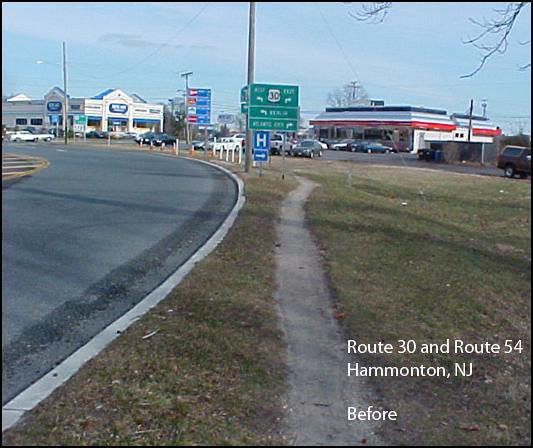
[/column]
[column size=half position=last]
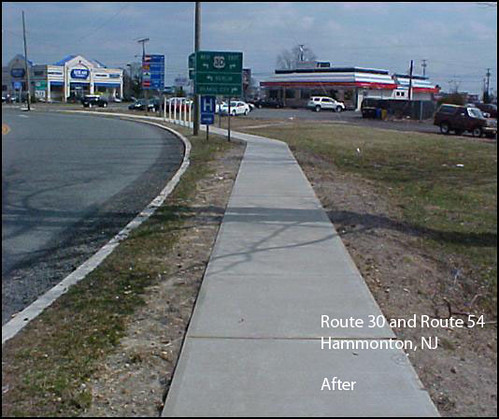
[/column]
These projects represent only a small portion of projects that have repaired, replaced, or installed sidewalks throughout the state. With the passage of over twenty-five Complete Streets policies – and hopefully many more in the future – New Jersey stands to benefit significantly from improvements in pedestrian accommodations. By doing so, state and local officials are providing residents with safe and efficient alternatives to driving.
For more information, or if you have any comments on pedestrian projects in New Jersey, please contact the Bicycle and Pedestrian Resource Center at bikeped@rci.rutgers.edu.
[1] Donor Funds Safer Streets in Little Falls, NJ
[2] Traffic Calming & Pedestrian Safety in Little Falls, NJ
[3] Dover, NJ Circulation Element
[4] Black Horse Pike in Atlantic County called fourth most dangerous road in state for pedestrians
